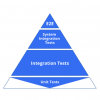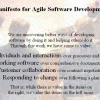 |
The Eroding Agile Test Pyramid The test pyramid is a great model for designing your test portfolio. However, the bottom tends to fall out when you shift from progression testing to regression testing. The tests start failing, eroding the number of working unit tests at the base of your pyramid. If you don't have the development resources required for continuous unit test maintenance, there are still things you can do.
|
|
 |
4 Strategies for a Structured QA Process Being a software tester is no longer just about finding bugs. It is about continuous improvement, defining a clear test strategy, and going that extra mile to improve quality. Following a consistent, structured approach to QA will help you acquire more knowledge about the product you are testing, ask questions you otherwise may not have thought of, and become a true owner of quality.
|
|
 |
Endgame Testing: Exploring Your Agile Product End to End The main goal of endgame testing is to test the system end to end from the user's perspective. This should ensure continuity between components developed by different teams, continuity in user experience, and successful integration of new features. Endgame testing will often identify gaps that are difficult to discover inside agile teams, including flows across the product.
|
|
 |
Slim Down Your Test Plan Documentation Test plans are essential for communicating intent and requirements for testing efforts, but excessive documentation creates confusion—or just goes unread. Try the 5W2H method. The name comes from the seven questions you ask: why, what, where, when, who, how, and how much. That's all you need to provide valuable feedback and develop a sufficient plan of action.
|
|
 |
Let the Agile Manifesto Guide Your Software Testing Although its values are commonly associated with agile software development, the Agile Manifesto applies to all people and teams following the agile mindset, including testers. This article examines the four main values of the Agile Manifesto and reveals how they can bring agility to test efforts—improving quality for your team and your customers.
|
|
 |
Get Smart about Your Regression Tests’ Value If you aren’t measuring the coverage your regression tests provide, you may be spending too much time for little benefit. Consider the value of your regression tests as you create and manage them. You need to be smart about the regression tests you maintain in order to gain the maximum value from the work put into creating, running, and analyzing their results.
|
|
 |
Acceptance Criteria, Specifications, and Tests One of the benefits of agile is how it helps specify requirements. Instead of trying to predict the future with your requests, you can wait an iteration and see if more criteria are needed. This article gets into how executable specifications, specification by example, and test automation can help further improve your requirements management.
|
|
 |
Test Automation in the Agile World After decades of talking about test automation, the agile movement suddenly seems to be taking it seriously. You might be wondering what all the buzz is about. Sanjay Zalavadia talks about why test tooling is suddenly so critical, when teams should think of automating, and how to bring the change so that your team will embrace it.
|
|
 |
Guide Your Agile Development with Traceable Tests Testing professionals who are learning about agile often want to know how they can provide traceability among automated tests, features, and bugs and report on their testing progress. Here, Lisa Crispin gives an example of how her previous team worked together to integrate testing with coding and helped everyone see testing progress at a glance.
|
|
|
|
Agile Performance Testing Approaching performance testing with a rigid plan and narrow specialization often leads to testers' missing performance problems or to prolonged performance troubleshooting. By making the process more agile, the efficiency of performance testing increases significantly—and that extra effort usually pays off multi-fold, even before the end of performance testing.
|
|

